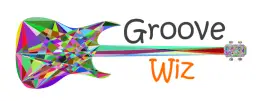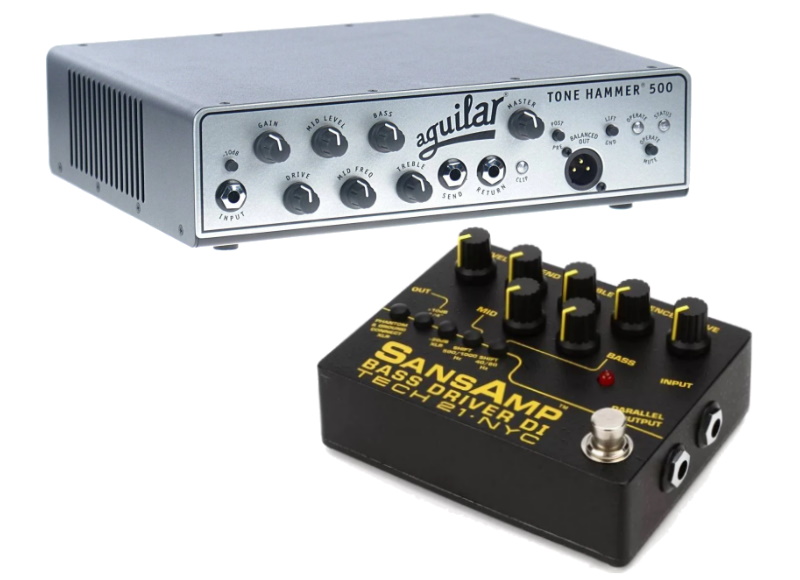Many bass players have faced the dilemna of choosing between two market leading pedals for bass, the Aguilar Tone Hammer or the SansAmp Bass Driver.
In short, the SansAmp BDDI has great distortion, strong tone coloration, no mid control, and SVT-like amp emulation. The Aguilar Tone Hammer, on the other hand, is transparent, crisp and modern sounding with mid control and remarkable Adaptive Gain Shaping. Both are equally good pedals for what they are designed to do.
The SansAmp BDDI emulates the classic Ampeg tone – gritty and assertive. The name “Sans Amps” hints at what it was made for – to go from the pedal straight into the FOH by eliminating the need for an amp. As a DI or preamp to a power-amp, it is an affordable imitation of the expensive SVT Classic amp head.
The Aguilar Tone Hammer DI pedal is a versatile preamp that can morph from hairy modern grit to vintage style tones with just a few tweaks. It offers more tone control with a fully sweepable mid controls and cut/boost in the treble, mid, and bass frequencies.
Let’s take a brief look at each one and explore their salient aspects in a head-to-head comparison.
Table of Contents
Aguilar Tone Hammer Preamp/DI Box Review
A guilar’s Tone Hammer DI is a transparent unit with great headroom and mid-control. The TH AGS circuit gives a dB boost – a gritty mid-focused tone when engaged that does not color your tone.
The midrange control on the Tone Hammer is proficient and powerful – voiced to sound unique and capable of a wide range of sounds.
The AGS circuit is great if you enjoy some grit – which you probably do even if you don’t know it yet. You can describe the dirt as ‘hairy’ sounding and at low gain settings the AGS sounds very close to a tube sound.
Aguilar has included the option of a footswitch to engage/disengage AGS on the fly. However, you likely won’t click the AGS as you would in a dirt/overdrive pedal because the spike in gain is too severe – you should generally adjust the gain manually when you switch it in.
The AGS circuit has its own appeal – dirt that some players prefer to use as a part of their principal tone. Others find the clean tone w/ AGS not engaged to be a better use of the pedal.
SansAmp Bass Driver DI review
The SansAmp BDDI is DI/Pre that is best known for an its unique tone and assertive overdrive. It can be used for live performance, recording, and/or as an emergency DI for gigs.
This pedal gives you a distinct tone with just the right amount of edge, but the BDDI knob settings are sensitive and you might have trouble recreating a good tone repeatedly.
It takes some time to fine-tune it but it is well worth it in the end if you like the SVT-ish tone coloration. With enough twiddling of knobs, it can even recreate an Ampeg B-15 sound to a T.
The 3 channel PBDDI version allows you to find the perfect sound and save it to one of the 3 digital presets that you can access on the fly. It is a better option compared to the standard pedal if you need different tones at the click of a switch.
The drive knob is far from subtle but there are many takers for this aggressive tone. However, this is not to be confused with a distortion/overdrive pedal. If you are looking for that, it would make more sense to opt for the SansAmp VT.
The BDDI is better as an amp simulator that rounds out the entire sound of your rig. Think of it as an amp-modeling pedal that doesn’t sound cheesy.
Tone Hammer vs. SansAmp: head to head comparison
TH vs BDDI: construction
The pristine Aguilar DI and the high-quality SansAmp DI are at par with anything you will need for the stage or studio. They both are similar in terms of construction quality and components with the Aguilar having a slight advantage.
The Aguilar weighs 2.4 lbs with 2.6″ x 5.5″ x 4.4″ dimensions. The SansAmp BDDI weighs 1 lb and the dimensions are 2.5” x 4.2″ x 5.8″. Each of them is built like a tank, so there is no real difference in durability. The knobs on both units feel sturdy. You can use them for a good number of years before you see enough wear to warrant a replacement.
TH vs BDDI: usability
SansAmp BDDI is decidedly more straightforward and easier to use.
The BDDI uses a standard power supply – 9V adaptor. The Tone Hammer does not ship with a power supply. It can run on phantom power or 2 x 9V Batteries. The 18V operation can be a hassle or strain on your power brick or pedalboard but it does give you more headroom for that hassle.
Secondly, the BDDI is simpler to use in terms of the interface. Tone Hammer is more complex because of additional functionalities, but many of those aren’t very practical/useful. It isn’t a plug-and-play pedal – you have to tweak and twirl until you find your sweet spot. However, once you get there, you will likely be very happy with the tone.
TH vs BDDI: tone
Between the two units, the Tone Hammer is irrefutably more natural and transparent. The drawback is that once you dial it to your desired bass tone, that is it. This is not a gain pedal, it’s meant for tone shaping your bass tone – once.
The SansAmp Bass Driver DI is very versatile and can be used in various genres and styles. The Drive and Presence controls are for tube circuit & amp emulation. The Blend knob is to balance the emulation and dry signal, which can go from a subtle tubey-ness all the way to entirely removing your dry signal.
The BDDI is cherished (or sometimes disregarded) for its tone coloration – a certain sonic spunk that it adds to the sound even when the pedal is set to as neutral as possible. It definitely adds something to the core tone, and as is always the case with tone coloration. Chances are you either will love it or hate it.
The Tone Hammer is crisp, transparent and clean, similar to a modern SS channel. There is no tone coloration, while the AGS engaged tone is more vintage or tube-like with a saturated signal.
Unfortunately, a significant design flaw (or glaring oversight) causes too much variance in the two tones if you switch on the fly. There is no way to match levels on the two channels because of the lack of a separate control for AGS.
This means that, when you crank the AGS, it won’t turn up the regular channel as long as the AGS switch is off but the minute you activate AGS, the volume will shoot up.
TH vs BDDI: price
The BDDI is more affordable, at under $210 vs under $250, but it is hard to correlate price with value because of the divergent tonalities.
TH vs BDDI: other Considerations
If you don’t like the BDDI tone coloration, you can use it as a transparent preamp/DI’s just for tonal shaping by turning off the SansAmp circuit. You can achieve a completely flat response by turning the blend controls counterclockwise and the EQ controls to zero.
If you like the SansAmp sound but really miss the mid-control, you may dish out an extra $100 for the rack-mount version, aka the RBI. It is loaded with features and has the tonal control that the BDDI is missing. The RBI is a modular rack setup, however, so the mid-control comes at the cost of portability.
If you are leaning towards Aguilar, check the preamp in your bass first. If you have an OBP-3 preamp (or something very similar), then getting the Tone Hammer might be redundant unless you absolutely love the AGS or have multiple bass guitars.
If you have access to a technician, you can get the Tone Hammer modded with an output level attenuator pot on the AGS circuit. If you cannot get the mod, you might need another pedal to cut AGS levels or boost the non-AGS levels.
You can also use the TH as an always-on preamp with the AGS engaged. The gain and master knobs are capable of dialing-in all the growl you need. Although, it would certainly be great if Aguilar would relaunch this pedal with a separate control for AGS.
Final words
The Tone Hammer can come in handy for a lot of things except providing overdrive with an adjustable boost. It ‘could be’ the undisputed winner if you could kick in the AGS drive circuit with a way to control the gain from unity up, but you can’t do that.
Therefore, it loses that edge (or value for money) because you need to use a separate overdrive pedal or use it as a one-tone preamp. Moreover, you need to drop some extra cash to buy an adaptor to power it.
The SansAmp BDDI can handle multiple things and offers a high-quality DI with reasonable tone-shaping, but you really need to get excited with the sonic character of the pedal.
The good news is that the tube emulation gives you a reason for such excitement. It is a likeable supplement to the tone that many players fawn over. If you are one of them, there is no better pedal that will do it at this price.
In any case, the SansAmp tone color and the TH transparency/modernity will be a deciding factor in your purchase. Both of these pedals are memorable enough for your soundman to send you a Christmas card.
***
Photo credits:
Featured image: courtesy of Aguilar and SansAmp

